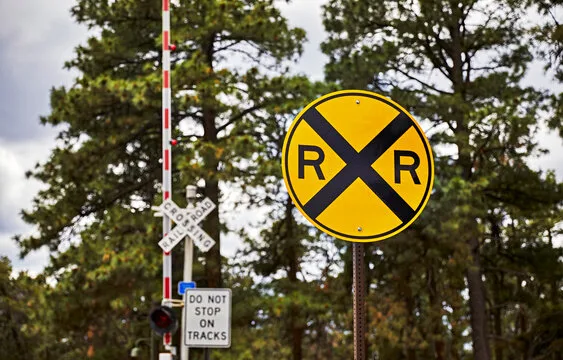Railroad crossings are crucial intersections where caution is paramount. Trains are massive and unstoppable, making collisions incredibly dangerous. By understanding the risks and adhering to safety protocols, drivers can significantly enhance safety at these crossings. This comprehensive guide explores essential tips for navigating railroad crossings with confidence.
Understanding the Risks:
Trains are behemoths on the tracks. Their immense size and momentum make them formidable forces. Recognizing this inherent danger is the first step towards prioritizing safety at railroad crossings.
The Railroad Crossing Sign: Your Warning Beacon
Look out for the iconic yellow circle with a black X in the center. This is the railroad crossing sign, a passive warning system alerting drivers to approaching railroad tracks. It serves as a constant reminder to be aware of your surroundings and prioritize safety.
Here's a quick breakdown of the railroad crossing sign:
Shape: Bold yellow circle
Symbol: Black X in the center
Location: Found before a railroad crossing, often accompanied by pavement markings
Alertness and Awareness:
- Stay Vigilant: Eliminate distractions and focus on the road when approaching railroad crossings. This includes avoiding cell phones, loud music, or conversations that divert your attention.
- Anticipate Train Presence: Trains operate on flexible schedules. Always be on the lookout for a train's arrival, regardless of the time of day.
Respecting Signals and Signs:
- Heed Warning Signals: Never ignore flashing red lights or crossing gate signals. These signals indicate an approaching train and demand a complete stop.
- Compliance with Regulations: Obey all traffic signals and signage at railroad crossings. Never attempt to go around closed gates – it's a recipe for disaster.
Giving Way to Trains:
- Yield to Trains: Always prioritize yielding to trains at railroad crossings, as indicated by crossbuck signs. There's no contest between your vehicle and a train.
- Avoid Racing Trains: Never engage in a race with a train. Their speed and proximity make such attempts incredibly dangerous.
Safely Navigating Railroad Crossings:
- Maintain Safe Distances: Stop at a safe distance from the tracks to ensure clearance for passing trains. This distance allows ample space to react and ensures personal safety.
- Remain Attentive: Look out for multiple tracks and additional trains that might be present after the initial train has passed.
- Emergency Preparedness: Familiarize yourself with emergency procedures in case your vehicle gets stuck on the tracks. Immediate evacuation and seeking assistance are crucial.
Special Considerations for Certain Vehicles:
- Mandatory Stops: Exercise caution and patience when encountering vehicles obligated to make complete stops at railroad crossings, such as school buses and those transporting hazardous materials.
Safety Tips at Railroad Crossings
Approaching with Care:
- Exercise Caution: Approach railroad crossings with heightened awareness. Use your turn signals to indicate your intention to slow down.
- Preparation: Before reaching the crossing, minimize distractions by turning off loud music and fans. Locate your phone for emergency use.
Stopping and Assessing:
- Maintain Distance: Stop at a safe distance from the nearest rail, ensuring at least 15 feet but not exceeding 50 feet.
- Visual and Auditory Vigilance: Look and listen for oncoming train traffic. Bend forward if necessary to enhance visibility around obstacles.
Crossing with Caution:
- Judicious Decision-Making: Only cross the tracks when there's ample space on the other side to accommodate your vehicle's dimensions. Don't rush through.
- Continuous Vigilance: Before proceeding, double-check the crossing's safety by scanning both directions for trains.
Dealing with Emergencies:
- Immediate Evacuation: If your vehicle stalls or becomes stuck on the tracks, evacuate immediately! Move away from the tracks at a 45-degree angle towards the oncoming train.
- Emergency Contact: Locate and use the emergency phone numbers posted near the crossing to report the incident promptly to the authorities.
Conclusion:
Effective safety measures at railroad crossings rely on everyone's commitment. By integrating these guidelines into your driving practices, you can significantly contribute to preventing accidents and ensuring the safety of yourself and others on the road. Remember, stay alert, respect railroad signals, and prioritize safety at all times.


